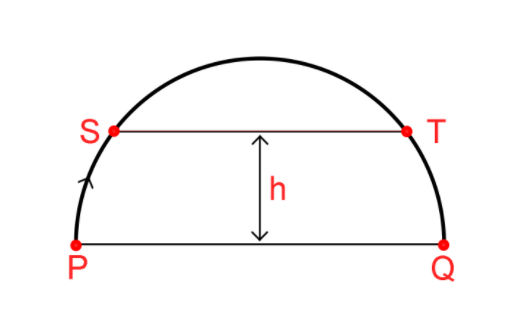
Answer
444.9k+ views
Hint: You can start by explaining projectiles. Then write the equation for the time of flight of a projectile and the equation for the maximum height i.e. \[t = \dfrac{{2u\sin \theta }}{g}\] for the motion of projectile from point $P$ to $Q$ and from $S$ to $T$ and calculate the value of \[u\sin \theta \] and \[u'\sin \theta \]. Then use the equation Maximum height \[ = \dfrac{{{u^2}{{\sin }^2}\theta }}{{2g}}\] and calculate the maximum height for the motion of projectile from point $P$ to $Q$ and from $S$ to $T$. Then find the difference between these two to reach the solution.
Complete step-by-step answer:
Projectiles are bodies that are launched with some initial velocity, reach a certain maximum height while covering a certain horizontal range. An example of projectiles is a ball thrown into the sky.
Given time of flight of a projectile for motion from point \[P\] to \[Q = 4\sec \] and for the motion from point \[S\] to \[T = 2\sec \] .
Let’s assume that the velocity of the projectile at the point \[P\] is \[u\] and the velocity of the projectile at the point \[S\] is \[u'\] .
We know that the equation for the time of flight of a projectile is
\[t = \dfrac{{2u\sin \theta }}{g}\]
So, for the motion of the projectile from point \[P\] to \[Q\] , we have
\[\dfrac{{2u\sin \theta }}{g} = 4\sec \]
\[u\sin \theta = \dfrac{{4g}}{2} = 2g\]
\[u\sin \theta = 20m/s\] (Taking \[g = 10m/{s^2}\] )
And, for the motion of the projectile from point \[S\] to \[T\] , we have
\[\dfrac{{2u'\sin \theta }}{g} = 2\]
\[ \Rightarrow u'\sin \theta = g = 10m/s\]
We also know that the equation for the maximum height is
Maximum height \[ = \dfrac{{{u^2}{{\sin }^2}\theta }}{{2g}}\]
So, the maximum height for the motion of the projectile from point \[P\] to \[Q\] is
\[H = \dfrac{{{u^2}{{\sin }^2}\theta }}{{2g}} = \dfrac{{400}}{{2 \times 10}}\]
\[ \Rightarrow H = 20m\]
And, the maximum height for the motion of the projectile from point \[S\] to \[T\] is
\[H' = \dfrac{{u{'^2}{{\sin }^2}\theta }}{{2g}} = \dfrac{{100}}{{2 \times 10}} = 5m\]
\[\therefore h = H - H' = 15m\]
Hence, option A is the correct choice.
Note: In the solution above, we have used the equations for the time of flight of projectile and the maximum height of the projectile, i.e. \[t = \dfrac{{2u\sin \theta }}{g}\] and Maximum height \[ = \dfrac{{{u^2}{{\sin }^2}\theta }}{{2g}}\] respectively. We could also use the equations for motion, but it would be an unnecessarily long method.
Complete step-by-step answer:
Projectiles are bodies that are launched with some initial velocity, reach a certain maximum height while covering a certain horizontal range. An example of projectiles is a ball thrown into the sky.
Given time of flight of a projectile for motion from point \[P\] to \[Q = 4\sec \] and for the motion from point \[S\] to \[T = 2\sec \] .
Let’s assume that the velocity of the projectile at the point \[P\] is \[u\] and the velocity of the projectile at the point \[S\] is \[u'\] .
We know that the equation for the time of flight of a projectile is
\[t = \dfrac{{2u\sin \theta }}{g}\]
So, for the motion of the projectile from point \[P\] to \[Q\] , we have
\[\dfrac{{2u\sin \theta }}{g} = 4\sec \]
\[u\sin \theta = \dfrac{{4g}}{2} = 2g\]
\[u\sin \theta = 20m/s\] (Taking \[g = 10m/{s^2}\] )
And, for the motion of the projectile from point \[S\] to \[T\] , we have
\[\dfrac{{2u'\sin \theta }}{g} = 2\]
\[ \Rightarrow u'\sin \theta = g = 10m/s\]
We also know that the equation for the maximum height is
Maximum height \[ = \dfrac{{{u^2}{{\sin }^2}\theta }}{{2g}}\]
So, the maximum height for the motion of the projectile from point \[P\] to \[Q\] is
\[H = \dfrac{{{u^2}{{\sin }^2}\theta }}{{2g}} = \dfrac{{400}}{{2 \times 10}}\]
\[ \Rightarrow H = 20m\]
And, the maximum height for the motion of the projectile from point \[S\] to \[T\] is
\[H' = \dfrac{{u{'^2}{{\sin }^2}\theta }}{{2g}} = \dfrac{{100}}{{2 \times 10}} = 5m\]
\[\therefore h = H - H' = 15m\]
Hence, option A is the correct choice.
Note: In the solution above, we have used the equations for the time of flight of projectile and the maximum height of the projectile, i.e. \[t = \dfrac{{2u\sin \theta }}{g}\] and Maximum height \[ = \dfrac{{{u^2}{{\sin }^2}\theta }}{{2g}}\] respectively. We could also use the equations for motion, but it would be an unnecessarily long method.
Recently Updated Pages
How many sigma and pi bonds are present in HCequiv class 11 chemistry CBSE

Mark and label the given geoinformation on the outline class 11 social science CBSE

When people say No pun intended what does that mea class 8 english CBSE

Name the states which share their boundary with Indias class 9 social science CBSE

Give an account of the Northern Plains of India class 9 social science CBSE

Change the following sentences into negative and interrogative class 10 english CBSE

Trending doubts
Difference Between Plant Cell and Animal Cell

Difference between Prokaryotic cell and Eukaryotic class 11 biology CBSE

Fill the blanks with the suitable prepositions 1 The class 9 english CBSE

Differentiate between homogeneous and heterogeneous class 12 chemistry CBSE

Which are the Top 10 Largest Countries of the World?

One cusec is equal to how many liters class 8 maths CBSE

Give 10 examples for herbs , shrubs , climbers , creepers

The mountain range which stretches from Gujarat in class 10 social science CBSE

The Equation xxx + 2 is Satisfied when x is Equal to Class 10 Maths




